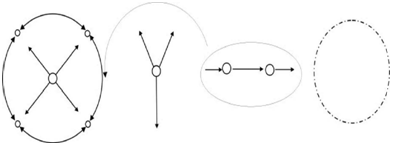Networks in Formal Communication:
You have seen how the formal organisational structure prescribes the channels by that communication flows take place. These channels are designed to remain the flow of information in an orderly manner and to protect the higher level managers from an overload of unnecessary information. Therefore, the way in that these channels are designed and work could affect the speed and accuracy of information as well as the task performance and satisfaction of members of the group. As such, managers have to think of how best to design the organisational structure and the communication network that meets the requirements of the situation.
Some research in the design of communication networks has been carried out that implies their relative merits for use in different situations. While these networks can assume several forms, the most often discussed are the wheel, chain, 'Y' and circle, shown in Figure.

Figure: Formal Networks
These forms could well be looked at as an organisational structure made up of five members.
The 'circle' network represents a three-level hierarchy in that there is communication among superiors and subordinates, along with cross communication at the operative level.
The 'chain' could represent a five-level hierarchy, in that communication could take place only upward and downward, and across organisational lines.
The 'wheel' or 'star' represents an administrator and four subordinates along with whom s/he interacts.
There is no interaction amongst the subordinates.
In the 'Y' network two subordinates report to the superior. It might be regarded as a four-level hierarchy.
The effectiveness of a communication pattern is determined through network centrality. The 'Y' and 'wheel' networks are highly centralized, along with the superior occupying the central position. The 'circle' and 'chain' networks are decentralized along with no member being able to influence all other members.
The centralized networks perform faster and more accurately for easy tasks. For complex tasks, the decentralized networks are comparatively quicker and more accurate.
The centrality of networks also influences the emergence of a leader and the satisfaction of group members. In centralized groups, while the tasks are easy or complex, one person who occupied the central position through virtue of the control of information emerges as the leader. In decentralized networks no one position could emerge as the leadership position.